A) Only I
B) Only II
C) I and II
D) I, II, and III
Correct Answer

verified
Correct Answer
verified
Multiple Choice
What is (are) the product(s) of the following reaction?

A) I
B) II
C) III
D) IV
Correct Answer

verified
Correct Answer
verified
Multiple Choice
What is the starting material in the following sequence of reactions?
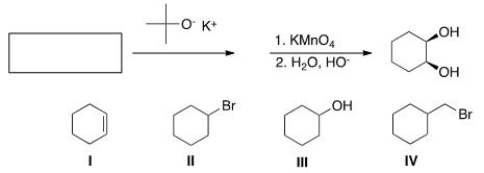
A) I
B) II
C) III
D) IV
Correct Answer

verified
Correct Answer
verified
Multiple Choice
What reagent is required to accomplish the following transformation?

A) Na, NH3
B) H2, Pd-C
C) H2, Ni
D) H2, Lindlar catalyst
Correct Answer

verified
Correct Answer
verified
Multiple Choice
What happens to the carbon atom in the transformation of chloromethane to methyllithium? CH3Cl + 2Li CH3Li + LiCl
A) Oxidized
B) Reduced
C) Oxidized and reduced
D) Neither oxidized nor reduced
Correct Answer

verified
Correct Answer
verified
Multiple Choice
What is (are) the product(s) of the following reaction?
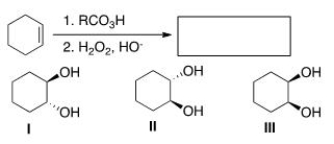
A) Only I
B) Only II
C) Only III
D) Only I and II
Correct Answer

verified
Correct Answer
verified
Multiple Choice
What is the correct classification of the following reaction?

A) Reduction reaction
B) Oxidation reaction
C) Elimination reaction
D) Substitution reaction
Correct Answer

verified
Correct Answer
verified
Multiple Choice
What is the correct classification of the following reaction?

A) Reduction reaction
B) Oxidation reaction
C) Elimination reaction
D) Substitution reaction
Correct Answer

verified
Correct Answer
verified
Multiple Choice
Determine the product of the following reaction. 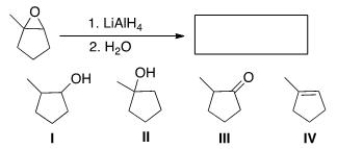
A) I
B) II
C) III
D) IV
Correct Answer

verified
Correct Answer
verified
Multiple Choice
Determine the product of the following reaction. 
A) I
B) II
C) III
D) IV
Correct Answer

verified
Correct Answer
verified
Multiple Choice
What is the starting material in the following reaction?

A) I
B) II
C) III
D) IV
Correct Answer

verified
Correct Answer
verified
Multiple Choice
Determine the product of the following reaction, ignoring stereochemistry. 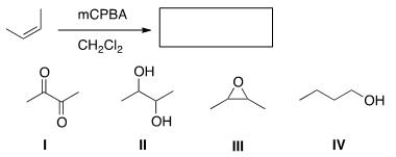
A) I
B) II
C) III
D) IV
Correct Answer

verified
Correct Answer
verified
Multiple Choice
Predict the major product of the following reaction. 
A) I
B) II
C) III
D) IV
Correct Answer

verified
Correct Answer
verified
Multiple Choice
Which is (are) the product(s) of the following reaction?
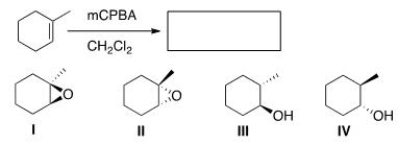
A) Only I and II
B) Only I and III
C) Only II and III
D) I, II, and III
Correct Answer

verified
Correct Answer
verified
Multiple Choice
Which of the following explains why heats of hydrogenation cannot be used to determine the relative stability of compounds A and B below?

A) Compound A is trisubstituted while compound B is monosubstituted.
B) Compound A has E configuration while compound B has no E/Z configuration.
C) Both compounds A and B have no E/Z configurations.
D) Hydrogenation of A and B give different alkanes.
Correct Answer

verified
Correct Answer
verified
Multiple Choice
What is the correct classification of the following reaction?

A) Reduction reaction
B) Oxidation reaction
C) Elimination reaction
D) Substitution reaction
Correct Answer

verified
Correct Answer
verified
Multiple Choice
Rank the following alkenes in order of increasing rate of hydrogenation. 
A) I < III < IV < II
B) IV < III < II < I
C) I < II < III < IV
D) IV < II < III < I
Correct Answer

verified
Correct Answer
verified
Multiple Choice
Which of the following statements about the reduction of epoxides with LiA1H4 is true?
A) The nucleophile is a hydride (H-) .
B) In unsymmetrical epoxides, nucleophilic attack of H- occurs at the more substituted carbon atom.
C) The reaction follows SN1 mechanism.
D) The nucleophile, H-, is a weak nucleophile.
Correct Answer

verified
Correct Answer
verified
Multiple Choice
What is the correct classification of the following reaction?

A) Reduction reaction
B) Oxidation reaction
C) Elimination reaction
D) Substitution reaction
Correct Answer

verified
Correct Answer
verified
Showing 21 - 39 of 39
Related Exams